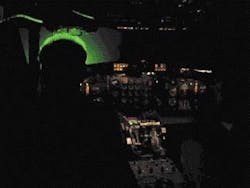Aviation-related display guidelines near publication
Simulator experiments completed by the US Federal Aviation Administration (FAA; Washington, DC) earlier this year have confirmed the 5-µW/cm2 upper limit for laser light shows in the vicinity of airports. Preliminary information has been released to avoid laser-related air safety incidents while a final FAA report and official information materials are being compiled.
The ball started rolling about five years ago with the accumulation of about 50 documented pilot complaints concerning aviation safety incidents related to illumination from laser light shows. At the time, the only restriction on laser power was a 2.6-mW/cm2 Food and Drug Administration (FDA) guideline that had been calculated to avoid permanent eye damage, but did not address the distraction and flash blindness issues of concern to airline pilots.
The difference between FDA guidelines and FAA needs in this instance led to the convening of an interdisciplinary group by the Society of Automotive Engineers (SAE) G10 human factors committee to establish aviation-related safety guidelines. The group included representatives from the US Air Force, US Army, Food and Drug Administration, laser manufacturers, law enforcement, laser users, the FAA Flight Standards Service, the Civil Aero Medical Institute (CAMI), and Air Traffic Control. The 5-µW/cm2 guideline was recommended, but concerns were raised, particularly by members of the pilot community, that the guideline needed empirical validation prior to implementation.
The tests were conducted in an FAA Boeing-727 simulator in Oklahoma City, OK, using a 532-nm Nd:YAG (yellow/green) laser. The laser was calibrated to preclude any illumination that would be biologically harmful or hazardous to test subjects. And the beam was directed into the subject's eyes using a fiberoptic cable and the simulator visual system to deliver a beam to the pilot's eye-point of about the size expected within the critical flight zone.
"The size of the beam was about the size of a basketball or a beach ball," said Archie Dillard, the FAA national resource specialist for simulation engineering who conducted the tests.
The illumination was routed into the cockpit via a fiberoptic cable. A personal computer (PC) selected the illumination scenarios on a totally random basis at different points in a landing pattern. The PC automatically set the proper power for the exposure and opened a shutter between the laser and the subject for one second. A timer in the PC provided an additional backup to ensure that no subject received more than a one-second exposure.
Illumination effects
After each illumination an observer would ask the subject to read the airspeed and altimeter to check for flash blindness or any interference with visual acuity. Subjects were also asked whether they found it unpleasant or whether they felt as if the illumination interfered with their duties. Each subject also filled out an extensive questionnaire at the conclusion of the experiment.
Test subjects ranged from 22 to 69 years of age and although the questionnaires have yet to be fully analyzed, no age-related effects were noted based on responses to initial cockpit questioning.
Each test subject was given a 50-µW/cm2 illumination on crossing the runway threshold to assess the effects of an exposure at a level above the 5-µW/cm2 target. And this portion of the test resulted in three missed approaches and validated the need for the 5-µW/cm2 exposure limit in terminal area operational airspace, Dillard said.
The nature of the visual interference that led to the missed approaches was characterized as a disruption to the normal flow of cockpit events, Dillard said. "It was bright, but we did not pick up much flash blindness or after-imaging at those illumination levels," he said.
When completed, the updated procedural guidance will be published as a revision to FAA Order 7400.2, Procedures for Handling Airspace Matters, in regard to "Outdoor Laser Operations" and also in an FAA Advisory Circular for laser "Critical Flight Zone" extending out to a 10-nautical-mile radius from the airport reference point and up to 10,000 feet above ground level.
About the Author
Hassaun A. Jones-Bey
Senior Editor and Freelance Writer
Hassaun A. Jones-Bey was a senior editor and then freelance writer for Laser Focus World.
